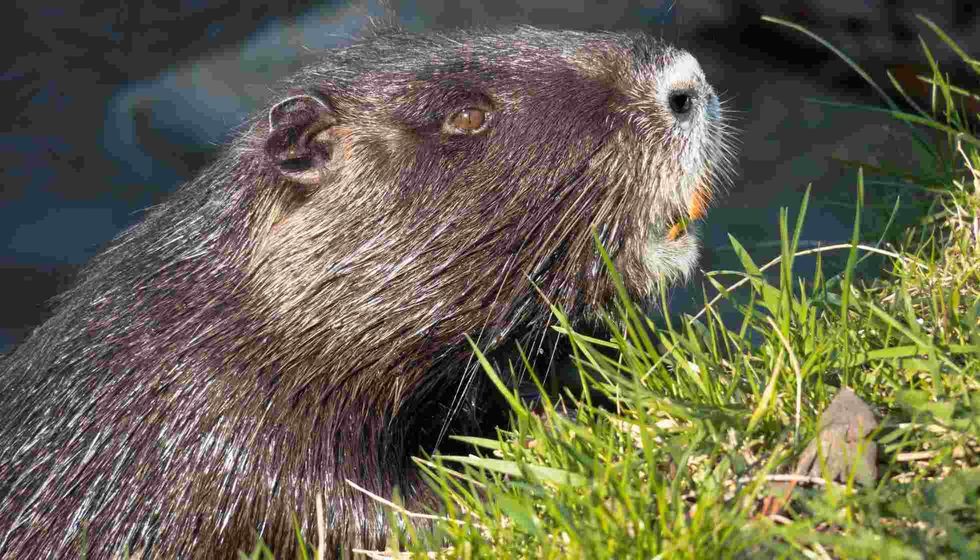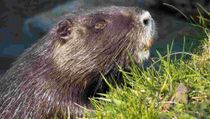The nutria rat is an invasive species native to the continent of South America but introduced in other places like Louisiana, Great Britain, and so on. These rodents are also known as coypus.
Nutria populations are seen near water bodies and they reside in wetland ecosystems. However, being an invasive species, nutria populations cause significant environmental damage in the ecosystem they live in.
The body of nutrias is covered in two kinds of fur, one of which is brown and the other of which is dark gray. Nutrias mainly eat plants in the wild. But sometimes they can also feed on mollusks and crustaceans.
The unique orange incisors of coypus give them a distinct identity. The rate of reproduction in this species is also quite high, which makes it difficult to control their numbers. Nutrias can reach sexual maturity as early as 6 months after birth.
Due to the presence of webbed hind legs, nutria rats are excellent swimmers. They also have certain physical modifications that help them in swimming underwater.
The fur of these animals is also an important commercial item. Nutria meat is also eaten in certain regions. Their meat is also used to make dog food.
To know more about nutria rats, continue reading! If you like this article, don't forget to check out marmot and foxes.
Nutria Rat Interesting Facts
What type of animal is a Nutria Rat?
Nutria rat is a species of rodent. They are also known as coypu.
What class of animal does a Nutria Rat belong to?
Nutrias belong to the class Mammalia. They are part of the order Rodentia like other rodents.
How many Nutria Rats are there in the world?
The exact number of nutrias present in the world is not known. However, according to the International Union for Conservation of Nature or IUCN, the population trend of these rodents is marked as decreasing, even though the population is not fragmented.
Where does a Nutria Rat live?
Nutria rats are native to South America. However, they have been introduced in other places where they have become an invasive species. Such places where populations of coypus are also seen are Louisiana, California, and along the Atlantic coast in North America, Ireland, Great Britain, and even New Zealand.
What is a Nutria Rat's habitat?
Nutria populations are most commonly found in the wetland ecosystem, in the wild. The nutria rat habitat mainly consists of marshes and other types of wetlands. They are known to live in burrows near the water bodies.
Who do Nutria Rats live with?
Nutria rats are highly social in nature. Usually, these animals live in large colonies in the wild along with each other. However, adult males might prefer being alone at times.
How long does a Nutria Rat live?
Nutrias can live as long as six years in the wild. In captivity, their lifespan is generally longer and can be of 10 years or more.
How do they reproduce?
Nutria rats are not seasonal breeders and hence, they can give birth throughout the year. The fertile period in the females is variable.
Once successful fertilization occurs in this fertile period, gestation can last anywhere between 126 to 141 days. The mother nutria gives birth to 3 to 12 offsprings after the gestation period. The mothers also display parental behavior.
What is their conservation status?
The conservation status of nutria rats has been marked as Least Concern by the International Union for Conservation of Nature (IUCN). Even so, the number of these rodents is reducing drastically in Argentina. This has been due to cattle ranchers encroaching on their range.
What do Nutria Rats look like?

Nutria rats or coypus are very large in appearance, with small eyes and ears. Their body is covered in two kinds of fur. The underfur is dark gray in color, while the outer fur appears to be different shades of brown; it could be yellowish-brown or reddish-brown.
Apart from their large size, which is quite striking in nature, the nutria rat teeth are also unique as they have bright orange incisors. Since these animals are semi-aquatic in nature, their hind legs are webbed.
Additionally, the hind limbs appear bigger than the forelimbs. Their tail is quite long and thin. The body of the male nutria rat appears bigger when compared to the female.
How do they communicate?
Coypus are known to communicate through vocalizations. Some of the sounds that they make are 'mew' or 'nancy' which sounds nasal. They can also convey messages to one another using chemical means.
How big is a Nutria Rat?
The nutria rat size is quite large when compared to other species of rodents. Their body length ranges from 18.5 to 22.6 in (47 to 57.4 cm), and they have a height between 8.3 to 11.8 in (21 to 30 cm). They appear larger in size when compared to a muskrat, which is another kind of rodent.
How fast can a Nutria Rat run?
Coypus are known to gain sufficient speed on land and as well as underwater. They can maintain their speed for long distances. Additionally, they are also adept at swimming and can spend up to 5 minutes being submerged in water.
How much does a Nutria Rat weigh?
The average weight for nutria rats ranges between 11 to 22 lb (5 to 10 kg). However, their body weight can increase to as much as 37.4 lb (17 kg).
What are their male and female names of the species?
The male and female animals of this species are referred to as male nutria rat or male coypu and female nutria rat or female coypu, respectively.
What would you call a baby Nutria Rat?
Nutria rat babies are known as newborns or offsprings. They can also be referred to as 'pups' like other rodent babies.
What do they eat?
The nutria rat diet mainly consists of different aquatic vegetation like roots, stems, and leaves. However, in some regions, nutria rats are known to consume mollusks and snails, as well. Hence, these animals are omnivorous in nature.
Are they dangerous?
In general, nutria rats are not aggressive in nature. Nevertheless, they can resort to biting if threatened.
To add to that, this species is known to carry some diseases and pathogens like septicemia and tuberculosis, that can affect humans and livestock. They are also carriers of parasites like tapeworms, liver flukes, and blood flukes. A kind of nematode these animals carry can cause 'nutria itch', which is a kind of rash.
Would they make a good pet?
It is possible to keep a nutria rat as a pet since they are usually calm and affectionate in nature. A nutria rat pet will need a large water enclosure and sufficient vegetation to survive healthily. Since it is not possible for everyone to provide all this, these animals are not that commonly seen as pets.
Did you know...
The first known description of nutria rats was given by Juan Ignacio Molina in the year 1782.
The name of the genus Myocastor (to which nutria rats belong), is taken from ancient Greek and is a combination of two words. The name translates to 'rat, mouse' and 'beaver'.
These rodents have special adaptations that allow them to swim underwater. These adaptations include valves that are present in their mouth and nostrils. When nutrias go underwater, these valves shut off and hence, prevent the entry of water into their bodies.
Since nutrias are mammals, the females have mammary glands. However, these glands are present on the side of the body. This modification allows the mother coypu to feed her offsprings even while floating on the water surface.
Coypus are able to build rafts out of different plant parts that can float on the water.
How does the Nutria Rat affect its environment?
Nutria rats are considered to be a kind of invasive species. Even though these animals are native to South America, their population was introduced in other places like Louisiana and Maryland (in North America), East Anglia (in the United Kingdom), and so on.
These rodents are known to feed on excessive amounts of aquatic vegetation that causes severe damage to the marshy and other wetland areas. With the loss of plants, wetlands disintegrate further.
The economic and environmental importance of wetlands is immense, and hence, damage to such a kind of habitat is quite detrimental. It is also quite difficult to control the population of nutrias as they have a very high breeding rate.
How does the Nutria Rat compare to other similar rodents?
Some of the other species of rodents that have a similar appearance to nutrias are beavers and muskrats. All three of these animals belong to the same order Rodentia.
When compared to beavers, nutrias appear smaller in size. The tails seen in beavers are also quite different from those belonging to the nutria rats.
The former has a paddle-shaped tail, while the latter has a thin tail. Both these animals have webbed hind limbs. Two separate species of beavers are native to North America and Eurasia, while nutrias are South American animals and have also been introduced in several places.
In the case of nutria rat vs muskrat, muskrats are native to North America but their populations have been introduced elsewhere. This species appears smaller than nutria rats.
The tails in muskrats are scaly in nature and flattened in a vertical manner, which is a unique characteristic. Muskrats also lack the orange-colored incisors seen in nutrias. Both these animals live in the same kind of ecosystem.
Here at Kidadl, we have carefully created lots of interesting family-friendly animal facts for everyone to discover! Learn more about some other mammal including a hamster, or a gopher.
You can even occupy yourself at home by drawing one on our Nutria Rat coloring pages.










